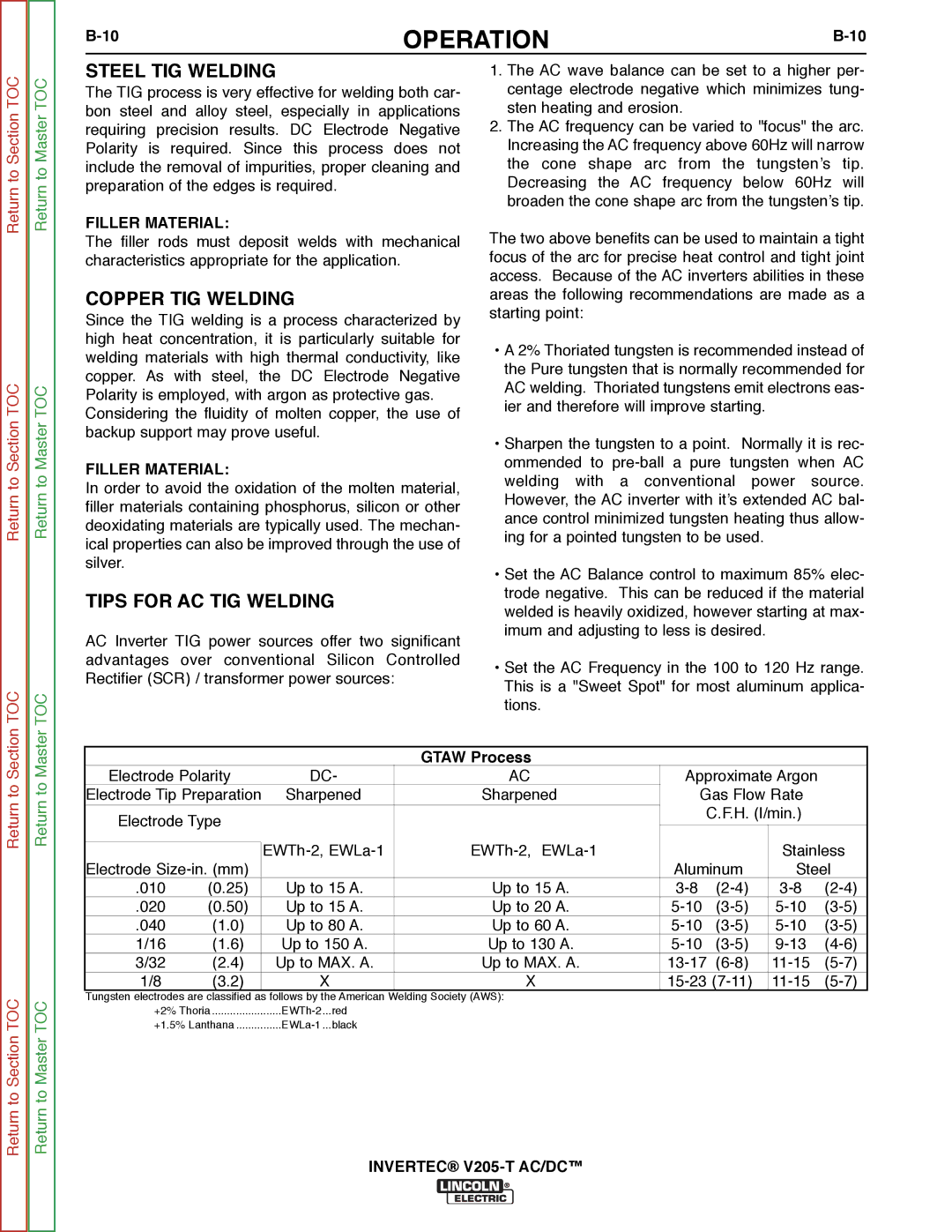
OPERATION | ||
|
Return to Section TOC
Return to Section TOC
TOC
Return to Master TOC
Return to Master TOC
TOC
STEEL TIG WELDING
The TIG process is very effective for welding both car- bon steel and alloy steel, especially in applications requiring precision results. DC Electrode Negative Polarity is required. Since this process does not include the removal of impurities, proper cleaning and preparation of the edges is required.
FILLER MATERIAL:
The filler rods must deposit welds with mechanical characteristics appropriate for the application.
COPPER TIG WELDING
Since the TIG welding is a process characterized by high heat concentration, it is particularly suitable for welding materials with high thermal conductivity, like copper. As with steel, the DC Electrode Negative Polarity is employed, with argon as protective gas.
Considering the fluidity of molten copper, the use of backup support may prove useful.
FILLER MATERIAL:
In order to avoid the oxidation of the molten material, filler materials containing phosphorus, silicon or other deoxidating materials are typically used. The mechan- ical properties can also be improved through the use of silver.
TIPS FOR AC TIG WELDING
AC Inverter TIG power sources offer two significant advantages over conventional Silicon Controlled Rectifier (SCR) / transformer power sources:
1.The AC wave balance can be set to a higher per- centage electrode negative which minimizes tung- sten heating and erosion.
2.The AC frequency can be varied to "focus" the arc. Increasing the AC frequency above 60Hz will narrow the cone shape arc from the tungsten’s tip. Decreasing the AC frequency below 60Hz will broaden the cone shape arc from the tungsten’s tip.
The two above benefits can be used to maintain a tight focus of the arc for precise heat control and tight joint access. Because of the AC inverters abilities in these areas the following recommendations are made as a starting point:
•A 2% Thoriated tungsten is recommended instead of the Pure tungsten that is normally recommended for AC welding. Thoriated tungstens emit electrons eas- ier and therefore will improve starting.
•Sharpen the tungsten to a point. Normally it is rec- ommended to
•Set the AC Balance control to maximum 85% elec- trode negative. This can be reduced if the material welded is heavily oxidized, however starting at max- imum and adjusting to less is desired.
•Set the AC Frequency in the 100 to 120 Hz range. This is a "Sweet Spot" for most aluminum applica- tions.
Return to Section
Return to Section TOC
Return to Master
Return to Master TOC
GTAW Process
Electrode Polarity | DC- | AC | Approximate Argon |
| |||
Electrode Tip Preparation | Sharpened | Sharpened | Gas Flow Rate |
| |||
|
|
|
|
| C.F.H. (l/min.) |
| |
Electrode Type |
|
|
|
| |||
|
|
|
|
|
| ||
|
|
|
| Stainless | |||
|
|
|
| ||||
Electrode |
|
| Aluminum | Steel | |||
.010 | (0.25) | Up to 15 A. | Up to 15 A. | ||||
.020 | (0.50) | Up to 15 A. | Up to 20 A. | ||||
.040 | (1.0) | Up to 80 A. | Up to 60 A. | ||||
1/16 | (1.6) | Up to 150 A. | Up to 130 A. | ||||
3/32 | (2.4) | Up to MAX. A. | Up to MAX. A. | ||||
1/8 | (3.2) | X | X | ||||
Tungsten electrodes are classified as follows by the American Welding Society (AWS): +2%
+1.5%
